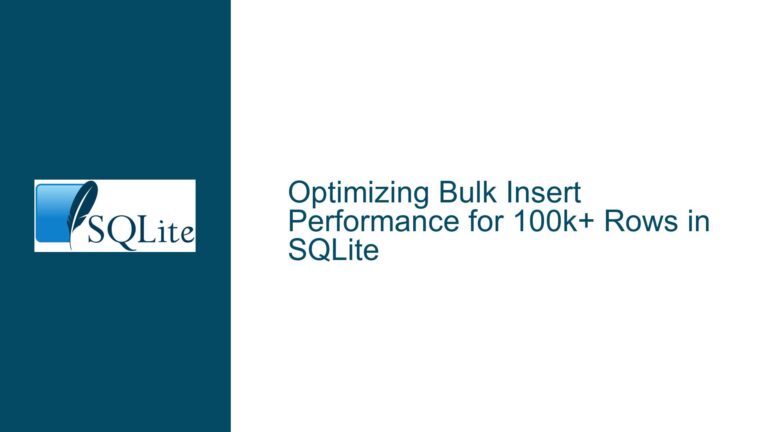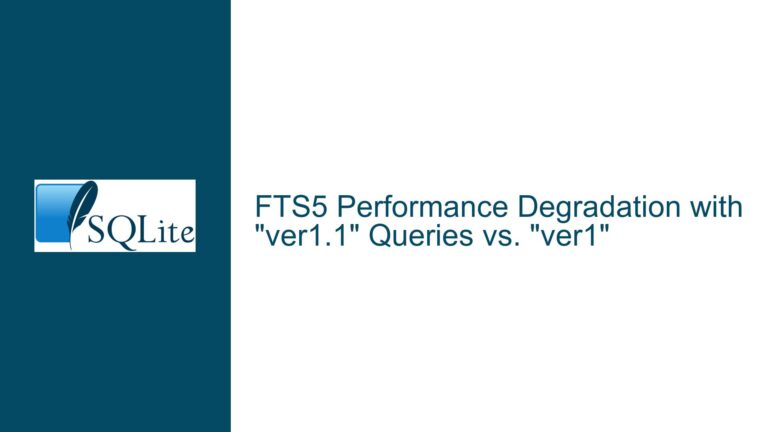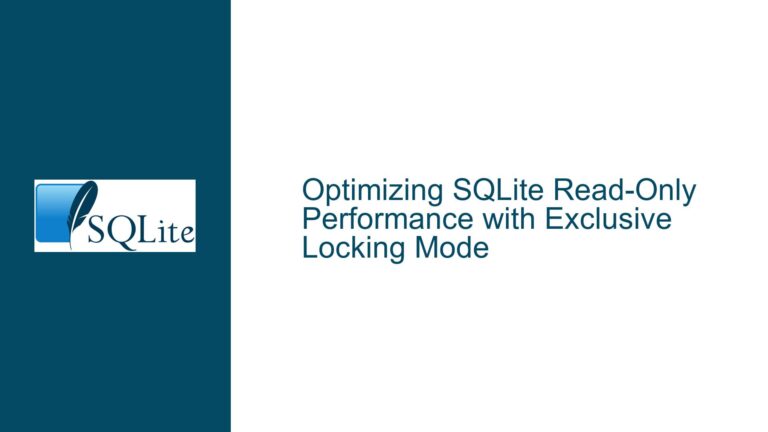Optimizing SQLite for High-Volume Append-Only Batched Atomic Writes
Understanding the Core Challenge of High-Volume Insertions in SQLite
The core challenge revolves around efficiently inserting a massive volume of data into an SQLite database while maintaining atomicity and performance. The database schema involves multiple tables with one-to-many relationships, where each table has an auto-incrementing primary key and indexed foreign keys to establish relationships. The primary issue is the slow performance of inserting rows into these tables, especially when dealing with millions of rows across multiple related tables.
The problem is exacerbated by the need to generate primary keys dynamically for each row, as these keys are required to establish relationships between tables. This dependency forces the insertion process to be sequential, as each row’s primary key must be known before inserting related rows into child tables. Additionally, the current approach involves executing individual INSERT statements for each row, which is inherently slow due to the overhead of repeated disk I/O operations and transaction management.
The goal is to optimize this process by leveraging SQLite’s features, such as transactions, WAL (Write-Ahead Logging), and efficient indexing strategies, to achieve high-performance, atomic, and append-only writes. The solution must also account for the potential need to roll back transactions in case of errors, ensuring data integrity without sacrificing performance.
Identifying the Bottlenecks in the Current Insertion Strategy
The current insertion strategy faces several bottlenecks that contribute to its inefficiency. First, the use of individual INSERT statements for each row results in significant overhead. Each INSERT operation involves parsing the SQL statement, generating a new primary key, updating indexes, and writing to disk. When multiplied by millions of rows, this overhead becomes substantial.
Second, the reliance on immediate disk writes for each INSERT operation further slows down the process. SQLite’s default behavior is to ensure durability by writing changes to disk immediately, which is necessary for data integrity but detrimental to performance in high-volume insertion scenarios.
Third, the current indexing strategy, which involves creating indexes on foreign key columns and other frequently filtered columns, adds to the overhead. While indexes are essential for query performance, they introduce additional write operations during insertion, as each new row must be indexed. This overhead is particularly pronounced when indexes are maintained during the insertion process rather than being created afterward.
Finally, the use of Python’s built-in sqlite3 module introduces additional inefficiencies. The module’s default behavior of managing transactions automatically can lead to unexpected commits and transaction boundaries, disrupting the intended batching of inserts. This behavior can be mitigated by explicitly controlling transaction boundaries, but it requires careful configuration.
Implementing Optimized Strategies for High-Performance Insertions
To address these bottlenecks, several strategies can be employed to optimize the insertion process. These strategies focus on reducing the overhead of individual INSERT operations, minimizing disk I/O, and leveraging SQLite’s features for efficient transaction management and indexing.
1. Batch Inserts and Transaction Management: The most effective way to reduce the overhead of individual INSERT operations is to batch multiple inserts within a single transaction. By wrapping multiple INSERT statements in a transaction, SQLite can defer disk writes until the transaction is committed, significantly reducing the number of disk I/O operations. This approach also allows SQLite to optimize the storage of multiple rows, as it can write them in a more contiguous manner.
To implement this strategy, the insertion process should be modified to group inserts into larger batches. For example, instead of inserting rows for a single file within a transaction, the process could insert rows for multiple files within a single transaction. The optimal batch size depends on the specific workload and available memory, but it should be large enough to amortize the overhead of transaction management while small enough to avoid excessive memory usage.
2. Deferred Index Creation: Another effective strategy is to defer the creation of indexes until after the data has been inserted. Indexes are essential for query performance but introduce significant overhead during insertion, as each new row must be indexed. By creating indexes after the data has been inserted, the insertion process can avoid this overhead entirely.
To implement this strategy, the insertion process should first insert all rows into the tables without any indexes. Once the data has been inserted, the indexes can be created in a single operation. This approach not only speeds up the insertion process but also allows SQLite to optimize the creation of indexes, as it can process all rows at once rather than incrementally.
3. Leveraging WAL Mode and Checkpointing: SQLite’s WAL mode can significantly improve write performance by allowing concurrent reads and writes. In WAL mode, changes are written to a separate WAL file rather than directly to the main database file. This approach reduces contention between readers and writers and allows for more efficient write operations.
However, WAL mode introduces additional complexity, as changes must eventually be checkpointed from the WAL file to the main database file. To optimize performance, the insertion process should configure WAL mode with appropriate checkpointing settings. For example, setting a larger WAL size and enabling automatic checkpointing can help balance performance and durability.
4. Optimizing Python’s SQLite3 Module Configuration: Python’s built-in sqlite3 module can introduce inefficiencies due to its default transaction management behavior. To mitigate this, the insertion process should explicitly control transaction boundaries by setting isolation_level=None when creating a connection. This configuration prevents the module from automatically committing transactions and allows the process to manage transactions explicitly.
Additionally, the insertion process should consider using the executemany method for batch inserts. This method allows multiple rows to be inserted with a single SQL statement, reducing the overhead of parsing and executing individual INSERT statements.
5. Parallelizing File Processing: While SQLite’s write operations must be serialized, the insertion process can still benefit from parallelization at the file level. Since each file is independent, the process can be parallelized by processing multiple files concurrently. Each parallel process can insert rows into the database independently, with its own transaction boundaries.
To implement this strategy, the insertion process should use Python’s concurrent.futures module or a similar parallel processing framework. Each worker process can handle a subset of files, inserting rows into the database within its own transactions. This approach can significantly reduce the overall insertion time, especially when dealing with a large number of files.
6. Configuring SQLite Pragmas for Optimal Performance: SQLite provides several pragmas that can be configured to optimize performance for high-volume insertions. These pragmas control various aspects of SQLite’s behavior, such as cache size, synchronous writes, and journal mode.
For example, increasing the cache_size pragma can improve performance by allowing SQLite to cache more data in memory, reducing the need for frequent disk I/O operations. Similarly, setting the synchronous pragma to OFF can improve write performance by allowing SQLite to defer disk writes, although this comes at the cost of reduced durability.
The insertion process should experiment with different pragma settings to find the optimal configuration for its specific workload. It is essential to balance performance and durability, as some pragma settings can increase the risk of data loss in the event of a crash.
7. Using SQL Triggers for Automated Insertions: SQL triggers can be used to automate the insertion of related rows into child tables. By defining triggers on the parent tables, the insertion process can automatically insert rows into the child tables when a row is inserted into the parent table. This approach can simplify the insertion logic and reduce the need for back-and-forth communication between Python and SQLite.
However, triggers introduce additional overhead, as they must be executed for each inserted row. The insertion process should carefully evaluate the trade-offs between the simplicity of using triggers and the potential performance impact.
8. Exploring Alternative SQLite Modules: While Python’s built-in sqlite3 module is convenient, it may not provide the level of control and performance required for high-volume insertions. Alternative modules, such as apsw (Another Python SQLite Wrapper), offer more control over SQLite’s behavior and can be more efficient for specific use cases.
The insertion process should consider using apsw or a similar module if the built-in sqlite3 module does not meet its performance requirements. These modules provide more fine-grained control over SQLite’s features, such as transaction management and pragma settings, allowing for more optimized insertion processes.
Conclusion
Optimizing high-volume, append-only batched atomic writes in SQLite requires a combination of strategies that address the various bottlenecks in the insertion process. By batching inserts, deferring index creation, leveraging WAL mode, optimizing Python’s SQLite3 module configuration, parallelizing file processing, configuring SQLite pragmas, using SQL triggers, and exploring alternative SQLite modules, the insertion process can achieve significant performance improvements while maintaining data integrity and atomicity.
Each of these strategies should be carefully evaluated and tested in the context of the specific workload to determine the optimal configuration. By combining these strategies, the insertion process can efficiently handle millions of rows across multiple related tables, ensuring high performance and reliability in high-volume data insertion scenarios.






